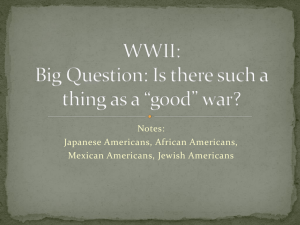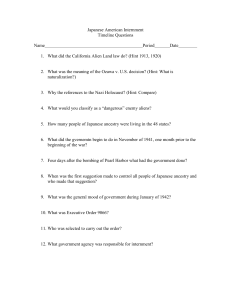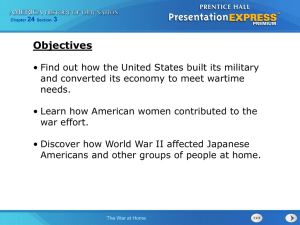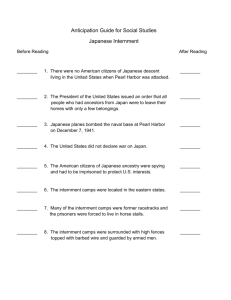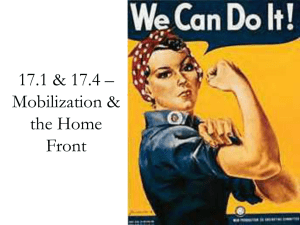Chapter 35 Notes
advertisement
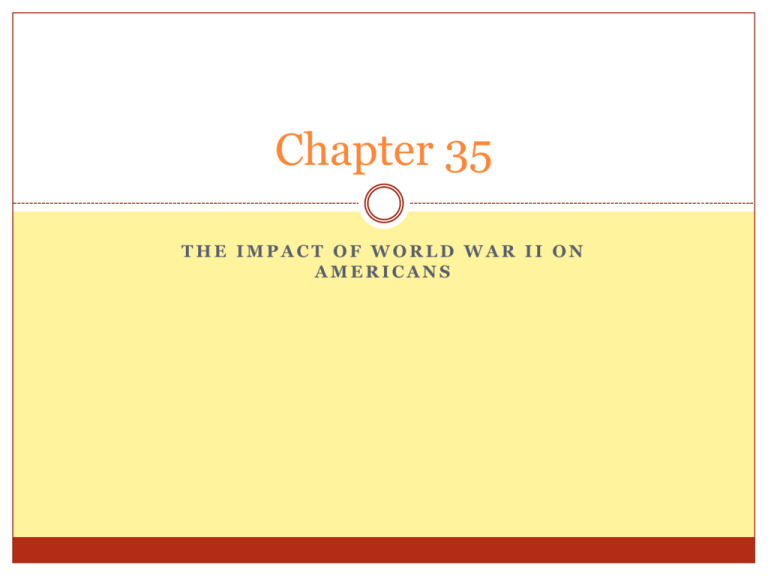
Chapter 35 THE IMPACT OF WORLD WAR II ON AMERICANS Organizing the American Economy for War War Production Board: the federal agency set up to manage the conversion of industries to military production during World War II he WPB’s main task was to manage the conversion of industries to military production A Wartime Production Boom Ends the Depression gross domestic product: the total value of the goods and services produced in a country in a year- Rises Rapidly-From 1940 to 1944, this basic measure of national output increased by 116 percent Personal income rises by more than 110% National War Labor Board (NWLB) was set up to mobilize labor. settle labor disputes before they disrupted the production of war goods. Organizing the American Economy for War Financing the War Effort with Taxes and Bonds More than $175 billion worth of defense contracts went out to businesses from 1940 to 1944 Taxes provided about 45 percent of the revenue needed to pay for the war The Revenue Act of 1942 increased individual and corporate income tax rates and more than tripled the number of individuals required to pay income tax. Set up system of withholding still used today Borrowing provided much of the rest of the money to finance the war war bonds not only provided the government with cash but also gave people a way to show their support for the war effort. Government Attempts to Curb Inflation and Consumption price controls: a system of legal restrictions on the prices charged for goods The OPA also rationed about 20 basic consumer products, including gasoline, tires, sugar, meats, and processed foods American GIs Go to War GI: a nickname for U.S. soldiers during World War II, derived from the GI ("government issue") label on many of their supplies By the time of the attack on Pearl Harbor, the draft had swelled the army’s ranks from 300,000 to a fighting force of more than 1.5 million troops. After the attack on Pearl Harbor, volunteers swamped military recruiting stations throughout the nation-nearly 6 million enlisted by the end of the war The trainers, or drill instructors, had as little as eight weeks to prepare men for combat. Instruction included tent pitching, map reading, guard duty, sanitation, weapons care, and endless physical training. Later, trainees took part in parachute jumping and live-ammunition exercises, which called for soldiers to crawl through the dirt while real machine gun bullets whizzed above their heads. Training could only do so much to prepare a GI for combat. The Internment of Japanese Americans When the attack on Pearl Harbor occurred, there were about 150,000 Japanese Americans living in the Hawaiian Islands Fearing sabotage, the War Department recommended the mass evacuation of Japanese Americans from Hawaii. On the mainland, concerns about disloyalty extended to people of German or Italian ancestry. Shortly after the Pearl Harbor attack, President Roosevelt signed proclamations declaring all German, Italian, and Japanese nationals, or non-U.S. citizens, to be “enemy aliens.” These orders affected more than 314,000 people of German ancestry, 690,000 people of Italian ancestry, and 47,000 people of Japanese ancestry. All “enemy aliens” had to register with the government and carry special identification cards. They had to turn in all firearms and cameras, as well as shortwave radios, which might be used to send information to the enemy. They also needed a travel permit to go more than 5 miles from their homes. internment camp: a center for confining people who have been relocated for reasons of national security government did round up several thousand German and Italian aliens and sent them to internment camps Executive Order 9066: an executive order issued by FDR in 1942 allowing internment camps to be set up to exclude current residents believed to be a threat to security The order to “move out and stay out” applied not only to Japanese “enemy aliens” but also to Japanese American citizens. Of the 127,000 people of Japanese ancestry living in the mainland United States, 80,000 were native-born American citizens Camps built quickly and poorly Officials allowed Japanese to join the Military in 1942 Women at War Rosie the Riveter represents women in the war effort About 18 million women took jobs outside the home during the war, up from 12 million before the war. Most women continued to work in occupations that were traditionally female, such as service, clerical, and sales work. Many women, however, took positions held traditionally by men. They became welders, mechanics, and lumberjacks, as well as lawyers, physicists, and architects. New Opportunities for Women in the Military Women’s Army Corps: a women's unit of the U.S. Army, established in 1942 Navy women were called WAVES and coast guard women were SPARs. Started in clerical work to free men up for combat but got into jobs such as truck driver, mechanic, radio operator, air traffic controller, and parachute rigger. A select few became pilots, mainly to ferry aircraft from factories to bases. Only WACs, however, served on the battlefield, working behind the lines in various support roles, including nursing. More than 200 American women died overseas as a result of enemy action. Rosie the Riveter African Americans Fight for Two Victories Double V campaign: a campaign in which black leaders called for all citizens to fight against racism by seeking a "double victory"—a victory for democracy at home and abroad Confronting Segregation in the Military the marines and army air corps refused to take any African Americans. The navy limited African American duties to cooking, cleaning rooms, and shining shoes. Tuskegee Airmen: a group of Army Air Corps pilots and support crews, established in 1941 as the first black combat unit gained a reputation for skill and courage, shooting some 400 German attackers out of the sky African Americans Fight for Two Victories Seeking Opportunity and Equality on the Home Front On June 25, 1941, Roosevelt signed Executive Order 8802, outlawing discrimination by defense contractors This executive order helped pave the way for nearly a million African Americans to work for defense industries during the war. It also triggered a migration of African Americans out of the rural South and into the industrial cities of the North and the West. From 1940 to 1945, some 500,000 black Americans, attracted by higher-paying jobs, left the South. They also faced a white backlash. -Riots Jewish Americans and the War Growing Alarm at Nazi Persecution of Jews American Jews started hearing reports of Nazi persecution in Germany shortly after Hitler took power in 1933. –Boycott, take away citizenship, sell their property November 9, 1938, the Nazis instigated a night of anti-Jewish rioting known as Kristallnacht, or the “night of broken glass. After Kristallnacht, thousands of Jews wanted to flee to the United States. But the 1924 National Origins Act placed severe limits on the number of immigrants from any one nation Steamship St. Louis Several factors kept the government from offering refuge to victims of the Nazis Most Americans were anti-Semitic and were unwilling to admit large numbers of European Jews Roosevelt also feared espionage and sabotage Government knows about what is happening in concentration camps- Don’t do anything to help War Refugee Board: an agency created in 1944 that arranged for Jewish refugees to stay at centers in Italy and North Africa, as well as in former army camps in the United States Jewish GIS More than 500,000 Jewish Americans went to war, including half of all Jewish men aged 18 to 44. In the armed forces, Jewish American GIs often felt the sting of prejudice but had a whole new world opened to them St. Louis Mexican Americans Leave the Fields for War Work About half a million Mexican Americans served in the armed forces during World War II A higher proportion of Mexican Americans fought in combat units than any other ethnic group Before the war, discrimination had barred most Mexican Americans from many high-paying industrial jobs. The war, with its labor shortages, changed that. Leave agricultural jobs for industrial ones In August 1942, the United States and Mexico devised the Bracero Program Mexican citizens received short-term contracts to come to the United States to work. By 1944, about 120,000 Mexican braceros were performing farm labor in 21 states. Zoot Suit Riot Mexican Americans there had little regular contact with white Americans. Relations between the two groups were hostile In 1943, a full-scale riot erupted in the barrio Zoot Suit Riots: racial clashes in Los Angeles in 1943 between mobs of sailors and marines and Mexican American youths who wore zoot suits They beat hundreds of pachucos and ripped off their suits. Police arrested the victims and hauled them off to jail, and did nothing to the soldiers
